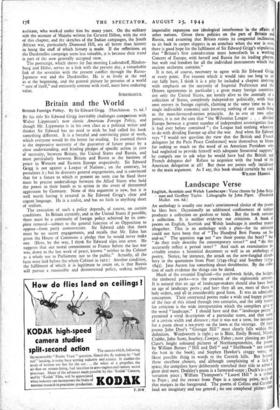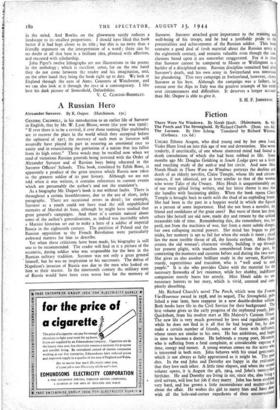Landscape Verse
AN anthology is usually one man's unwinnowed choice of the poems he likes best. Occasionally an additional confinement of subject produces a collection on gardens or birds. But the book remains a collection. It is neither evide,rce nor criticism. A book of poems on English, Scottish and Welsh landscape is another matter altogether. This- is an anthology with a plan—for its criterion could not have been that of "The Hunckred Best Poems on So- and-so." The question was not "are these poems the best?" but "do they truly describe the contemporary scene?" and "do they
accurately reflect a period taste? And such an examination in-
evitably creates a historical document as well as an anthology of poetry. Notice, for instance, the attack on the new-fangled shrub- bery in the quotations from Pratt (1749-1814) and Southey (1774- 1843). Jane Austen has something about shrubberies. By the colla- tion of such evidence the things can be dated.
Much of the essential England—the patchwork fields, the hedges, the timbered parks—was the creation of the eighteenth eenturY. It is natural that an age of landscape-makers should also have been an age of landscape poets ; and here they all are, most of them ns holy orders, and all in considerably good form. It was an admirable conception. Their contrasted poems make a wide and happy picture of the face of this island through two centuries, and the only maul for criticism is the wide interpretation which the compilers give 1: the word "landscape." I should have said that "landscape poetrY premised a vivid description of a particular scene, and that scene of a certain width and distance ; that it was not a term, for instance, for a poem about a tea-party on the lawn at the vicarage. Of thes: poems John Dyer's " Grongar Hill" most clearly falls within tins definition. Wordsworth is right ; so is Blair, Emily Brontë, Mason, Crabbe, John Scott, Southey, Cowper, Faber ; most pleasing are John Clare's bright coloured pictures of Northamptonshire, the poems by William Barnes (" Hill and Dell" and " Shellbrook " are agog the best in the book), and Stephen Hawker's craggy verse, the likest possible thing in words to the Cornish hills. But beyond these excellent .choices, and although complaining of a lack of• space, the compilers have deliberately stretched their title to admit great deal more. Dodsley's poem is a farmyard-scape ; Duck's is a con' versation piece • William Thempson's "Laurel Hill" is a tribut; to Pope ; and the extract from Pope is a sporting print, -with that matters in the foreground_ The poems of Collins and Curnb'''.
F. 20w land are imaginary and too general ; no one completed picture
in the mind. And Bowles on the glowworm surely reduces a landscape to its smallest proportions. I should have liked this book better if it had kept closer to its title ; but this is no more than a friendly argument on the interpretation of a word ; there can be no doubt at all that here is a brilliant idea, planned with affection, and executed with scholarship.
John Piper's twelve lithographs are not illustrations to the poems in the anthology ; which is excellent sense for on the one hand they do not come between the reader and his imagination, and, on the other hand they bring the book right up to date. We look at England through the eyes of Anne, Countess of Winchester, and we can also look at it through the eyts of a contemporary. I like best his dark picture of Stonesfield, Oxfordshire.
V. C. CLINTON-BADDELEY.



























 Previous page
Previous page